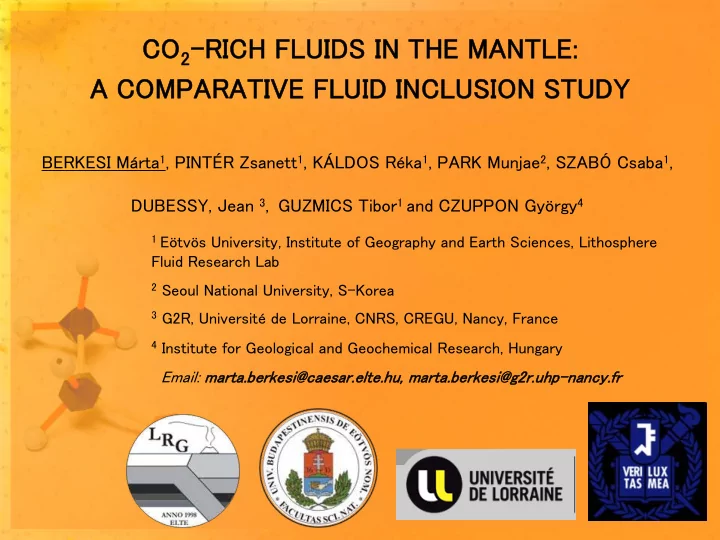

CO 2 -RICH FLUIDS IN THE MANTLE: A COMPARATIVE FLUID INCLUSION STUDY BERKESI Márta 1 , PINTÉR Zsanett 1 , KÁLDOS Réka 1 , PARK Munjae 2 , SZABÓ Csaba 1 , DUBESSY, Jean 3 , GUZMICS Tibor 1 and CZUPPON György 4 1 Eötvös University, Institute of Geography and Earth Sciences, Lithosphere Fluid Research Lab 2 Seoul National University, S-Korea 3 G2R, Université de Lorraine, CNRS, CREGU, Nancy, France 4 Institute for Geological and Geochemical Research, Hungary Email: marta.berkesi@caesar.elte.hu, marta.berkesi@g2r.uhp-nancy.fr
Introduction Transport of fluids through the convecting mantle are the least understood and state-of-the-art problems The composition and behavior at upper mantle depths of the supercritical aqueous fluids have been intensively studied (Keppler, 1996; Newton and Manning, 2000; Scambellurri and Philpot, 2001; Kessel et al., 2005; Hermann et al., 2006; Spandler et al., 2007) However, less information is available on CO 2 -rich supercritical mantle fluids and their interactions with peridotitic mantle wall rocks As study on fluid inclusion is the most suitable method to obtain information and evidences on upper mantle fluid systems (Roedder, 1984; Szabó and Bodnar, 1996; Andersen and Neumann, 2001), we aimed to carry out a complex study of a representative series of such fluid inclusions
Sampling – 5 continent’s rocks Pannonian Basin, Hungary Jeju- island S-Korea Rio Grande Rift, New-Mexico, USA Cameroon Volcanic Line Cameroon Mt. Quincan Quincan, , Mt. Vic ct to oria ria, , Vi Africa Austr Austra alia lia
Sampling – Balaton-highland (Hungary) The most significant outcrops of the mantle xenoliths in the Bakony— Balaton-Highland Volcanic Field Basaltic lava rocks Basaltic pyroclasts
The fluid inclusions-photomicrographs Opx fluid inclusions • Hosted mainly by silicates (e.g. Opx-orthopyroxene: Mg 2 Si 2 O 6 ) • At room temperature, commonly one visible liquid ± solid phase(s) within the inclusions • Occurs along healed fractures or in clusters Their size ranges between 2- 9 0 microns •
FLUID PHASES-Raman spectroscopy S H 2 Hungary, Cameroon SO 2 S-Korea, USA N 2 S-Korea, Australia, USA Detection of N 2 within the fluid inclusions became easy by using the LabRAM HR!
SOLID PHASES-Raman spectroscopy Enstatite – hosted fluid inclusion: • Magnesite • α -Quartz MgSiO 3 (enstatite)+CO 2 = MgCO 3 (magnesite)+SiO 2 (quartz) Diopside – hosted fluid inclusion: • Dolomite CaMgSi 2 O 6 (diopside) + 2CO 2 = CaMg(CO 3 ) 2 (dolomite) + 2SiO 2 (quartz) Berkesi et al. 2012 EPSL
Why FIB-SEM? • Calculation of the volume proportions for the solid phases • Morphology • Identification at submicron scale • Arbitrary size can be cut from the surface exposed by the ion beam and then see the exposed part of the inclusion by SEM and analyze with EDX. • The actual progress of the inclusion exposing process is monitored acquiring secondary electron (SE) images of the sample. Berkesi et al. 2012 EPSL
The “response” of Raman spectroscopy: FIB-SEM exposure technique Sample from Pannonian Sample from Mt. Quincan Basin (Hungary) (Australia) Qtz Opx Opx – orthopyroxene, Mgs – magnesite, Qtz – quartz GCM – Gallium contaminated material Berkesi et al. 2012 EPSL
SOLID PHASES-Raman spectroscopy and Infrared spectroscopy (mapping) Sample from Mt. Quincan, Australia Pargasite and phlogopite
S-bearing solids • Sulfides as well as sulfates were identified pointing out the significance of sulphur in mantle volatiles! Berkesi et al. 2012 EPSL
Concluding remarks 1) The fluid inclusions from mantle peridotites represent CO 2 -rich, S-, N 2 - and H 2 O-bearing fluid system as proved by Raman microspectrography at ambient and elevated temperatures. 2) Daughter phases including their volume proportions can be efficiently studied by the combined use of Raman spectroscopy and FIB-SEM technique on mantle fluid inclusions. 3) We can conclude that similarly to the rocks, building up the subcontinental lithospheric mantle, the co-existing fluid can also be heterogeneous in the mantle although the dominant component in each case is the common CO 2 . 4) The combination of heating freezing experiments and high resultion Raman microspectrography together with FIB-SEM technique allow us to determine or at least approximate the bulk composition of the fluid, which is in turn one of the main aims of the fluid inclusion studies.
Thank You for your attention! The European Union and the European Social Fund have provided financial support to the project under the grant agreement no. TÁMOP 4.2.1./B-09/KMR-2010-0003 This work has partly done in the framework of of the REG_KM_INFRA_09 Gábor Baross Programme (contract nr. OMFB-0038/2010).
Recommend
More recommend